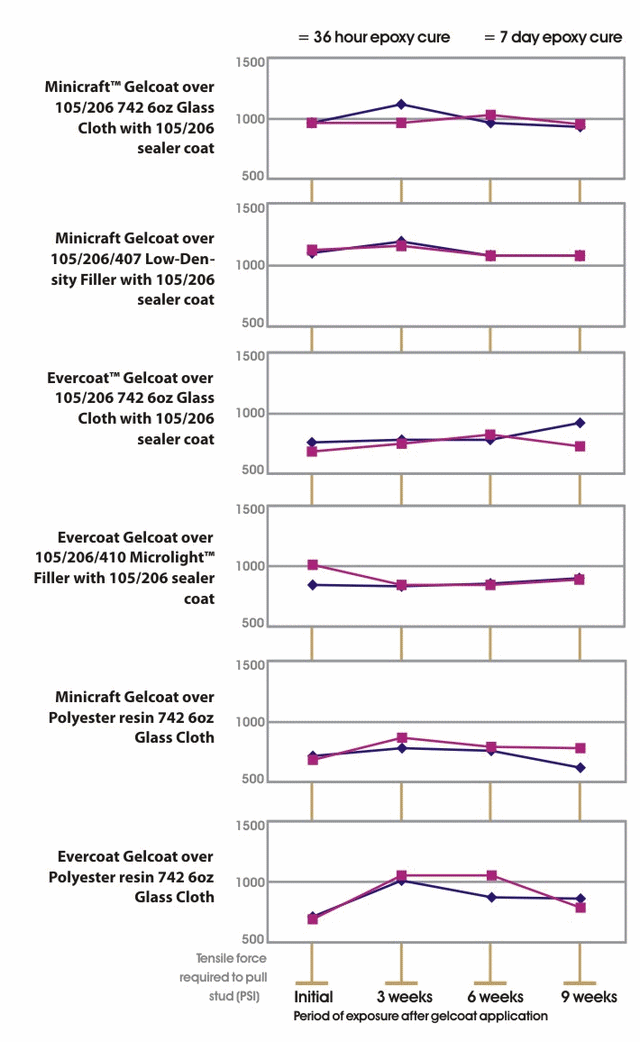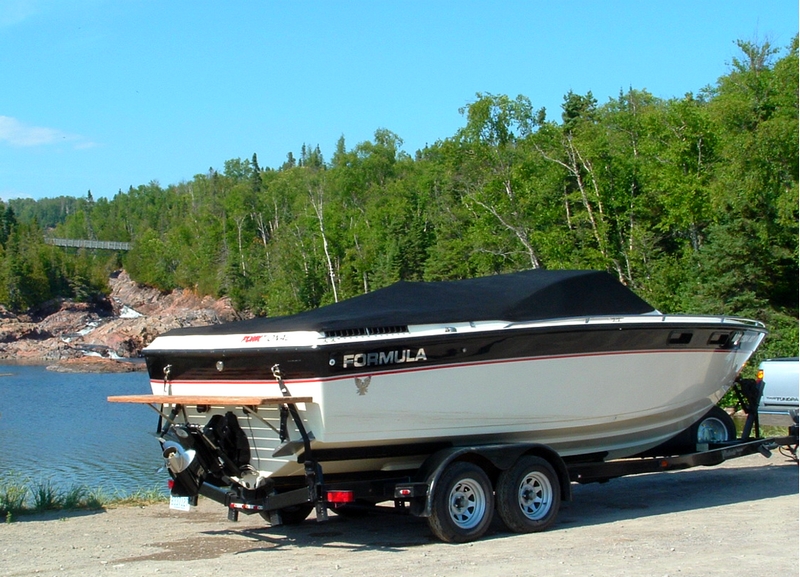
by Jeff Wright — Vice President of Technical Services
Most production fiberglass boats are made with polyester resin, and we’re often asked if it’s appropriate to use polyester gelcoat over epoxy. WEST SYSTEM® epoxy is a wonderful material for repairing polyester fiberglass boats. One reason for this is the ability of epoxy to form a stronger mechanical bond to a damaged laminate than polyester resin. Epoxy also provides a better moisture barrier than polyester resin.
Our customers’ fiberglass repairs range from filling a minor screw hole to completely rebuilding the bottom of a boat that ran aground. In most cases, a final finish needs to be applied over the repair. If the repair is above the waterline, high-gloss paint or gelcoat is often used to reproduce the original appearance. If the repair is below the waterline, antifouling paint is most often applied over the repaired area. However, customers often want to restore the original gelcoat finish to below-waterline repairs where the boat is kept in the water and no antifouling paint is applied. These customers are concerned about the gel coat’s long-term ability to adhere to the area repaired with epoxy. There are good reasons for this concern, but if you understand the materials involved and follow recommended repair procedures, you can successfully apply a gelcoat finish to a boat bottom repaired with WEST SYSTEM epoxy.
In repairs above the waterline, gelcoat applied over properly prepared WEST SYSTEM epoxy has a great track record. Many boats have been repaired this way and are performing well in a variety of climates. Boats that are dry-sailed or trailered have also had success with gelcoats on underwater epoxy repairs. Concern about adhesion occurs in situations where boats are in the water constantly and need to have a high level of finish on their bottoms that requires gel coat. Such a situation might occur with a boat kept in a pristine lake where antifouling paint is often not used. Since the polyester gelcoat is not very good at preventing moisture from permeating through to the laminate, there has been a concern that, over time, the gelcoat will detach from the more moisture-resistant epoxy layer.
Understanding polyester and epoxy
Polyester resin laminates achieve their highest strength when the bonds between layers of fiberglass are chemical or primary bonds as opposed to mechanical or secondary bonds. The manufacturing process for polyester boats has been developed so that a chemical bond exists between the gelcoat and the laminate. When a polyester boat is built, polyester gelcoat is first sprayed onto the mold surface. The first layer of the laminate is then applied to the gel coat, which has not completely cured. The two layers eventually cure together with a chemical bond between them.
Applying gelcoat to a cured laminate relies on a mechanical bond. Because of the difference in curing chemistry, it is not possible to achieve a chemical bond between epoxy and polyester gelcoat. We developed some tests to determine whether or not the mechanical bonds achieved between gelcoat and properly prepared, cured epoxy were strong enough to achieve a durable repair.
Testing polyester and epoxy
The test program we developed was designed to determine the effect of moisture on the adhesion of polyester gelcoat applied over fully cured epoxy. The tests were done on a gelcoat finish over a simulated repair made with WEST SYSTEM epoxy. The test included a variety of finishing processes. In addition, we varied the length of time the epoxy was allowed to cure before being subjected to high moisture conditions. For comparison, we also tested gelcoat adhesion to a polyester laminate using West Marine Boaters Resin.
Two popular gelcoats were used, Minicraft™ and Evercoat™. Interestingly, Evercoat states on their can that it is not to be used over epoxy. Although we often suggest following the manufacturer’s instructions, we believe, in this particular case, the manufacturer is overly conservative. As with many products, the surface must be prepared properly; if it is not, then poor curing and adhesion may result. Polyester materials can be affected by amines in the epoxy hardener. If the hardener has not fully reacted with the epoxy resin or the amine blush is not removed from the cured surface, problems can occur. Proper surface preparation will prevent these problems. (Download 002-550 Fiberglass Boat Repair & Maintenance for details.)
Preparing the test panels
The test panels were laminated from three layers of 738 Biaxial Fabric (15 oz biaxial with .8 oz mat) wet out with 105 Resin and 205 Hardener. Panels were covered with 879 Release Fabric and allowed to cure. This laminate provided a stiff panel that simulated a patch used to repair the bottom of a fiberglass boat. After the Release Fabric was removed, a variety of finishing processes were applied to the panels. These included using 742 Glass Fabric (6 oz), 407 Low-Density Filler, and 410 Microlight Fairing Filler™. All of the test panels had a sealer coat of 105 Resin/206 Slow Hardener to fill the weave and seal the scratches in the sanded fairing compounds. Slow Hardener was chosen because its slower reaction time would be more likely than 205 Fast Hardener to reveal any adhesion problems.
The gelcoat was applied using a pressure pot-type spray gun. It was thinned using 10% Acetone by weight, catalyzed at 1% with MEKP (Methyl Ethyl Ketone Peroxide). After the gelcoat cured for two weeks, PATTI (Pneumatic Adhesive Tension Testing Instrument) studs were applied to the surface.
One set of PATTI studs were pulled for a baseline value. Panels were then placed in our 100% humidity/100°F environment room. The conditions in this room accelerate any effect that moisture will have on the laminate. The remaining PATTI studs were pulled at three, six, and nine weeks to determine the long-term effect of moisture on the bond.
Figure 1 (right) lists the different material combinations that were sprayed with gelcoat. The graph for each combination shows the tensile load required to pull the stud off the panel at four time intervals, illustrating the trend of the bond strength when the gelcoat is applied after allowing the laminate to cure for 36 hours and 7 days. Each data point represents the average of five stud pulls.
Conclusion
The overall effect of moisture on the gel coat’s bond to both the polyester and epoxy panels was negligible. The graphs show very little change in the adhesive strength, and much of the variance is within the tolerance of the test method. When the studs were pulled, the failures occurred in the fairing compound, cohesive failure of the gelcoat, or in the bond between the gelcoat and laminate. Since these three modes of failure occurred under similar loads, it indicates that the strength of the bond is close to the cohesive strength of both the gelcoat and the fairing compound. The nine-week exposure may not simulate what could happen after many years, but it does indicate that the gelcoat bond to epoxy laminates is a good bond and should perform well.
Our test clearly demonstrates that polyester gelcoat will bond to a properly prepared WEST SYSTEM epoxy as well as to a cured polyester laminate. This test confirms that polyester gelcoats can be applied over cured WEST SYSTEM ™ epoxy on repairs below the waterline.







